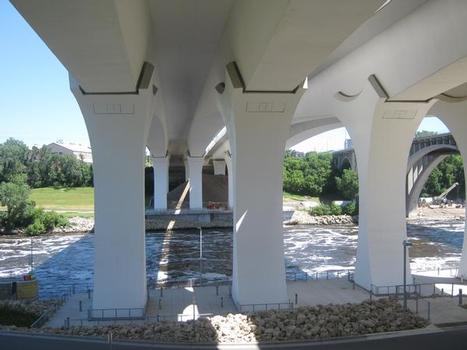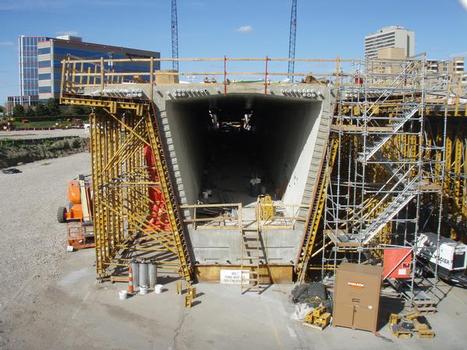General Information
| Other name(s): | I-35W Mississippi River Bridge |
|---|---|
| Official designation: | NBI 27410 (Northbound), 27409 (Southbound) |
| Beginning of works: | 30 October 2007 |
| Completion: | 18 September 2008 |
| Status: | in use |
Project Type
| Function / usage: |
Motorway bridge / freeway bridge |
|---|---|
| Structure: |
Box girder bridge |
| Material: |
Prestressed concrete bridge |
Location
| Location: |
Minneapolis, Hennepin County, Minnesota, USA |
|---|---|
| Address: | Interstate 35W |
| Crosses: |
|
| Replaces: |
I-35W Mississippi River Bridge (1967)
|
| Coordinates: | 44° 58' 44" N 93° 14' 41" W |
Technical Information
Dimensions
| main span | 153.6 m | |
| total length | 370.64 m |
Materials
| deck |
prestressed concrete
precast prestressed concrete |
|---|
Chronology
| 8 October 2007 | The Minnesota DOT awards a $243 million contract to a joint venture of Flatiron Constructors Inc. and Manson Construction. The design engineer is Figg Bridge Engineers, Inc. |
|---|---|
| 1 November 2007 | Expected beginning of construction. |
| December 2008 | Expected completion. |
Excerpt from Wikipedia
The I-35W Saint Anthony Falls Bridge crosses the Saint Anthony Falls of the Mississippi River in Minneapolis, Minnesota in the U.S., carrying north-south traffic on Interstate Highway 35W. The ten-lane bridge replaced the I-35W Mississippi River bridge, which collapsed on August 1, 2007. It was planned and is maintained by the Minnesota Department of Transportation (Mn/DOT). The planning, design, and construction processes were completed more quickly than normal because Interstate 35W is a critical artery for commuters and truck freight. The bridge opened September 18, 2008, well ahead of the original goal of December 24.
Collapse of the previous bridge
During the evening rush hour at 6:05 pm on August 1, 2007, the main spans of the I-35W Mississippi River bridge in Minneapolis collapsed and fell into the river and onto its banks, killing 13 people and injuring 145. The bridge opened in 1967, and was expected to carry 66,000 vehicles per day. Though intended to last fifty years, it collapsed after forty – approximately ten years short of the end of its useful life.
Originally, the bridge was striped for two lanes in each direction. In 1988, the four shoulders were converted to traffic lanes, accommodating four lanes in each direction. This allowed an increase in traffic flow. By 2004, an estimated 141,000 vehicles crossed the bridge each day.
Funding
Minnesotans at a US DOT press conference. Left to right: Gov. Tim Pawlenty, Mayor R. T. Rybak, Secretary Mary Peters behind Rep. Keith Ellison (speaking), Rep. Betty McCollum and Sen. Norm Coleman.Within hours of the previous bridge's demise, politicians pledged to rebuild the bridge at an accelerated pace. Federal transportation officials pledged US$5 million for the cleanup and recovery. U.S. Representative Jim Oberstar, who represented Minnesota's 8th congressional district and chaired the House Transportation Committee, introduced an earmark to direct a minimum of $250 million to help replace the bridge; the bill passed the House unanimously on August 3 as Republican Senator Norm Coleman and Democratic–Farmer–Labor (DFL) Senator Amy Klobuchar introduced companion legislation in the Senate. President George W. Bush signed the legislation on August 6, 2007, after visiting the site on August 4. After months of wrangling with Congress over spending proposals, President Bush signed the spending bill that included funding for the bridge on December 26, 2007.
Design debate
Minneapolis Mayor R. T. Rybak (DFL) said that future needs and policy considerations shouldn't be ignored in the rush to build a replacement and sought a new bridge able to handle increased traffic as well as mass transit. Meetings between state transportation officials (Mn/DOT), Rybak, State Transportation Commissioner Carol Molnau, and Governor Tim Pawlenty yielded a desire to build a 10 lane bridge that will last 100 years, with the possibility of bus rapid transit or light rail lines. Rybak said, "Transit needs to play some role in this or otherwise we would need to build a much wider bridge in the future." At a public forum in Roseville, hundreds of Twin Cities residents participated in a discussion about the bridge design. The overriding theme of the crowd was a desire to plan for the bridge's use of mass transit. Commissioner Molnau, in conjunction with Metropolitan Council Chairman Peter Bell, recommended that light rail not be incorporated in the new bridge design. But Pawlenty, responding to constituents and the mayor, directed Mn/DOT to design the bridge to be light rail-ready. He said the estimated additional $20 to $35 million would be paid for by the state.
Award of contract
After the collapse of the bridge's predecessor, Mn/DOT announced to potential contractors that they should express their intention to bid on the project by August 8, 2007. A typical bridge project of this scale in Minnesota would be expected to take three years to complete, but state transportation officials hoped to open this replacement bridge in 15 months by using a design/build contract that allowed design and construction of the bridge to proceed concurrently. Mn/DOT announced on August 9 that five companies/consortia had been approved to bid on the project and requested that the bids be submitted by September 18, 2007.
Flatiron Constructors, Inc. and Manson Construction Co. were awarded the contract on September 19, 2007; Flatiron's was the highest-priced and longest schedule of the bids submitted. The lead designer was Figg Engineering, with Ayres Associates providing hydraulic and scour analyses. TKDA of Saint Paul was the engineer of record for the approach highways, second street bridges, retaining walls, lighting, and water resource engineering services on the project. While the total cost was expected to be between USD $300 million and $350 million for the 1,900-foot (579 m) multi-span bridge, including financial incentives for accelerating the schedule, the winning bid was for USD $234 million. Disincentives for missing the completion date of December 24, 2008 included a $200,000 per day penalty, while incentives to finish early could have been as much as $27 million.
Construction
MnDOT maintained a project page that tracked all activities associated with the construction of the bridge including weekly updates, traffic impacts, construction photos, animations, and virtual walk tours. On December 17, 2007, the first slab of concrete, 200 feet (61 m) long, 13.5 feet (4.1 m) wide, and 4.5 feet (1.4 m) thick, was poured off-site, which began to shape the bridge. Pilings sunk 100 feet (30.5 m) into the earth support the ends of the bridge, which contains 50,000 cubic yards (38,000 m³) of concrete.
The bridge construction progressed more quickly than expected. Construction work was performed in shifts with as many as 400 workers during the day, and 200 at night. On April 8, 2008 Mn/DOT announced the halfway point of construction had been reached, and predicted that completion might be ahead of schedule by as much as three months.
This prediction was borne out by events, as the Minnesota Department of Transportation opened the bridge to traffic at 5:00 in the morning on September 18, 2008. Minnesota State Patrol cars at both the north and south ends allowed rush hour traffic to build up behind them. Once the construction barricades were removed at 5:00 am first responders, state troopers, and Mn/DOT trucks slowly crossed the bridge with rush hour traffic in tow, officially opening the bridge. The team constructed the $234 million bridge three months ahead of schedule and on budget, with no lost time due to safety accidents. Flatiron-Manson was expected to earn $27 million in bonuses for accelerated performance.
Technology
The bridge is equipped with anti-icing sprayers and was constructed with high-strength concrete. There are 323 sensors that regularly measure bridge conditions such as deck movement, stress, and temperature. The data will be compiled and analyzed by University of Minnesota personnel. The bridge is illuminated with LED lights. Although LED lighting is not generally approved for such highways, this bridge roadway illumination is a test project. The bridge also incorporates multichromatic decorative lighting, which is used to illuminate the structure at night.
The bridge makes use of a special photocatalytic concrete called TX Active for the construction of two decorative sculptures that resemble the symbol for water used on maps. This material reacts with ultraviolet light and pulls pollutant particles of carbon monoxide, sulfur dioxide, and nitrous oxide out of the air and converts them to less harmful substances. The sculptures contain a compound that makes them self-cleaning, so they should stay white for as long as they stand.
The concrete comprising the drilled shafts, piers and footings contained large levels of replacement of Portland Cement with slag, flyash and other pozzolans. These materials reduce the embodied energy of the structure and allow the concrete to resist the ingress of water and dissolved solids such as chloride ion. This allowed the structure to be designed to resist deterioration for much longer than structures made with conventional concrete.
Awards
The project has won over 20 awards for excellence, including the Federal Highway Administration's Award of Excellence, the FIATECH Celebration of Engineering and Technology Innovation Award, the 2010 Award of Excellence from the Portland Cement Association, and the National Council of Structural Engineers Association's Excellence in Structural Engineering Award. The bridge has been named a project of the year by the American Public Works Association.
The bridge won the 2009 America's Transportation Awards, a prize sponsored by AASHTO, for "representing the best in innovative management, accountability and timeliness".
Text imported from Wikipedia article "I-35W Saint Anthony Falls Bridge" and modified on July 23, 2019 according to the CC-BY-SA 4.0 International license.
Participants
Relevant Web Sites
Relevant Publications
- Dual purposes. In: Bridge Design & Engineering, v. 14, n. 51 (2nd Quarter 2008), pp. 64.
- (2008): The New St. Anthony Falls Bridge. In: ASPIRE (Winter 2008).
- Rapid construction spells success for I35W replacement. In: Bridge Update, n. 76 (June 2008), pp. 1.
- Twin win. In: Bridge Update, n. 71 (October 2007), pp. 4.
- Wiederaufbau der I-35W Brücke über den Mississippi in Minneapolis in Rekordzeit vollendet. In: DSI Info, n. 17 ( 2009- 2010), pp. 74-75.
- About this
data sheet - Structure-ID
20030440 - Published on:
22/08/2007 - Last updated on:
27/01/2022

.jpg)






